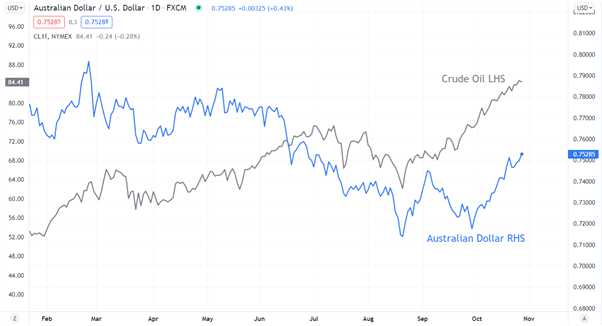Australian Dollar, AUD/USD, US Dollar, CPI, RBA, Energy - Talking Points
- Australian Dollar leapt up as CPI Trimmed Mean overshot expectations
- The inflation outlook appears stubborn for central banks as energy prices soar
- The RBA is unlikely to change course. What does it mean for AUD/USD?



The Australian Dollar rose immediately after the Australian CPI numbers today. Third quarter headline inflation came in at 0.8% q/q against expectations of 0.8%. The annual headline rate came in 3.0% y/y versus 3.1% forecasted. The RBA’s preferred measure of trimmed mean printed at 0.7% q/q instead 0.5% anticipated, which made the annual read 2.1% y/y against 1.8% expected.
This means that headline CPI had some downward revisions, but trimmed mean had some upward revisions.
The 3rd quarter saw more than 50% of the Australian population in lockdown and economic activity was understandably expected to fall away. Consequently, price pressures were also anticipated to be benign. The uptick in the trimmed mean CPI is not desirable for the RBA, but it is unlikely to be enough to change their tightening agenda.
Globally, inflation is a hot topic. Supply chain issues aside, energy prices have sky-rocketed over the last few months as the northern hemisphere prepares to go into winter. A number of factors have led to demand out-stripping supply.
In North America, a challenging hurricane season in the Gulf of Mexico sapped output. Taking a look across the Atlantic, a broken gas pipe between the UK and Europe and Russia holding out on the EU to get their pipe under the Balkans approved kept prices afloat. Meanwhile, China and India are competing for power to reduce rolling blackouts. This is as the Asian typhoon season wreaks havoc and closes several mines. Shipping costs are through the roof as ports remain clogged due to Covid and OPEC+ under supplying oil.
As the world vaccinates and reactivates economically, some of these issues will likely be mitigated. That may not happen for some time and high energy prices might stay with us. Although the cost of domestic energy is regulated in most parts of the world, this has led to many energy supply companies going broke.
These energy companies are forced to buy wholesale power at high prices and sell it at mandated lower prices to retail consumers. Without large government subsidies, this is not sustainable. Eventually, consumers will face higher prices. Unless something drastic changes, these inflation pressures are coming down the pipe, but the timing of when they surface is not yet known.
If high energy prices stay with us for the long haul, the implications are two-fold for the Australian Dollar. Firstly, as an energy exporting country, this will likely lead to a better bottom line on the trade balance and consequent buying of AUD.
Secondly, high inflation might be stickier than central banks are anticipating. It could lead to a monetary policy tightening race, driving up rates. How quickly the RBA responds may determine yields across the curve, and this can play a role in the attractiveness or otherwise of the Australian Dollar.




--- Written by Daniel McCarthy, Strategist for DailyFX.com
To contact Daniel, use the comments section below or @DanMcCathyFX on Twitter






